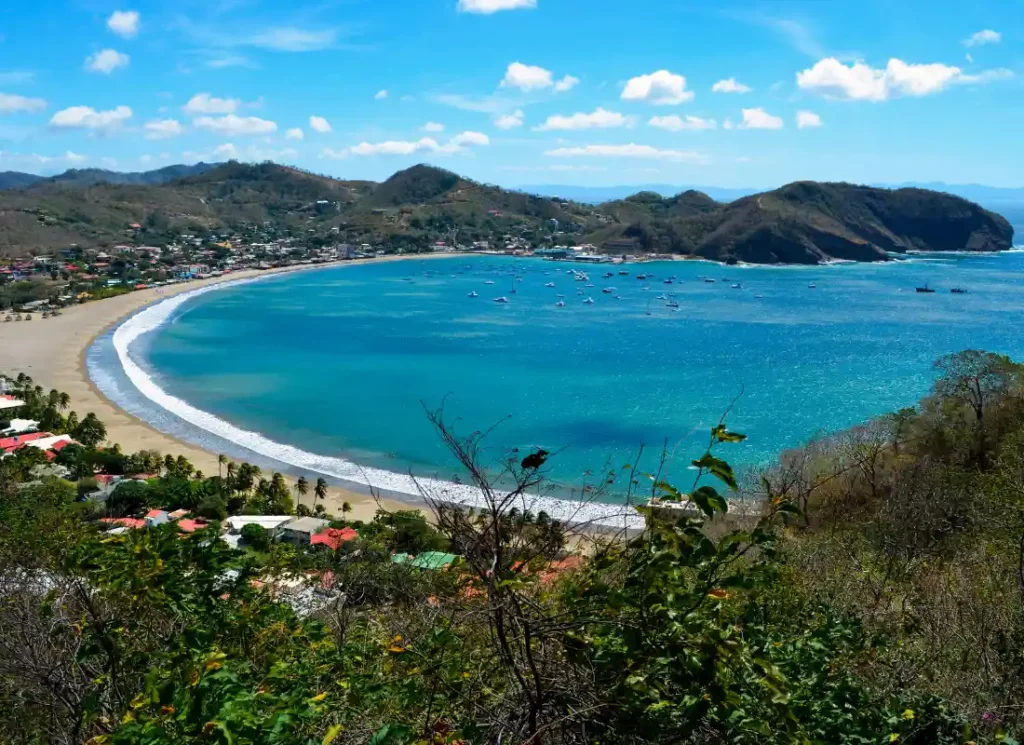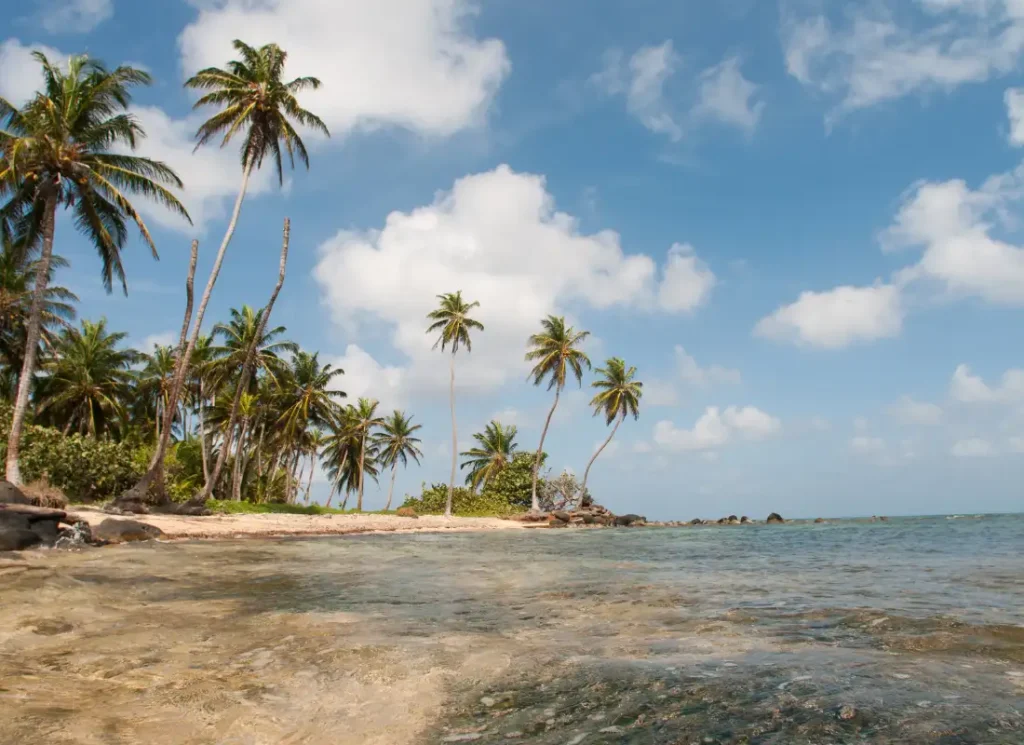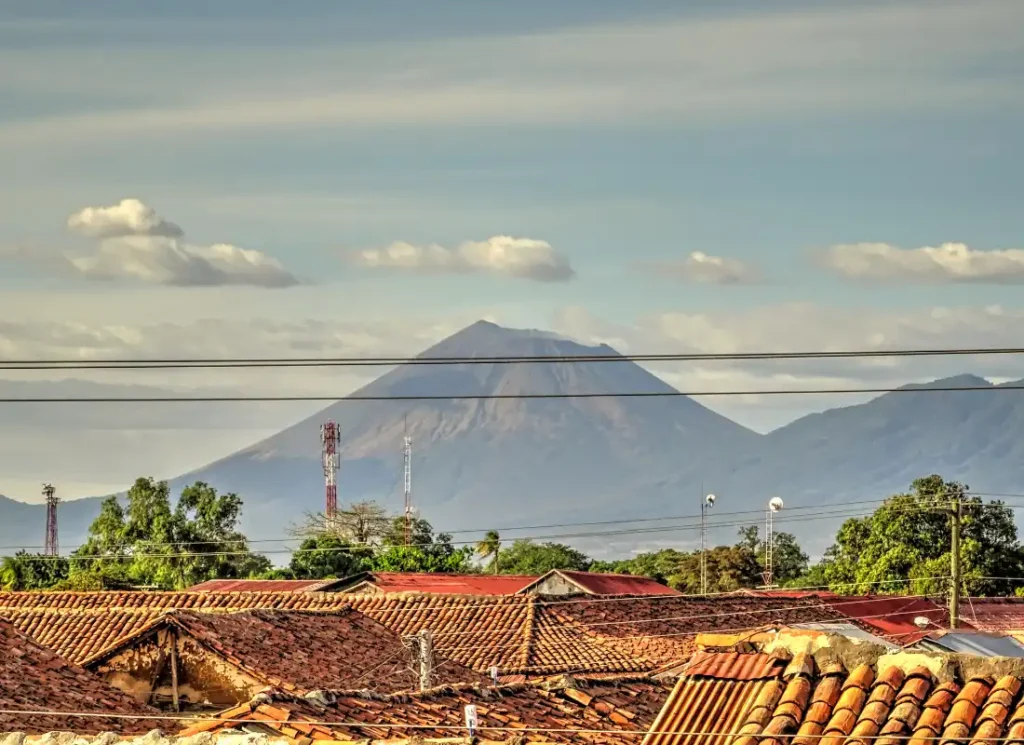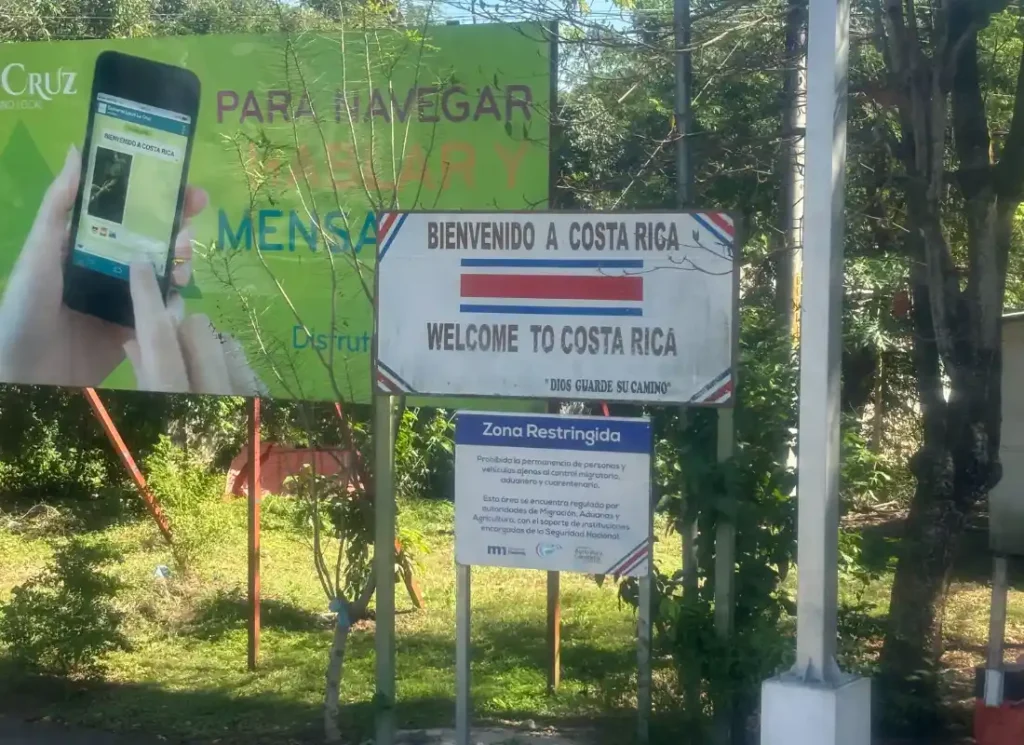Everything you need to know for your backpacking trip in Nicaragua! What’s the best time to go, and where can you find vegetarian or vegan food? What is the currency in Nicaragua, and do you need to protect yourself against mosquitos? And more questions answered about backpacking in Nicaragua in this ultimate guide.
Nicaragua’s tourism industry is growing at a huge rate right now, but it is very new to the country. Whilst in other countries in Central America like Costa Rica, Panama and Guatemala have more robust travel and accommodation for tourists, I found that in Nicaragua things were less organised, more hectic, and less tailored to travellers.
This made for a unique travel experience and I definitely had a great time and felt like I really got to know the country. However I did feel less safe than in other countries and I was quite glad to be travelling with my friend Ellie for this portion of my trip.
Managua
Nicaragua’s capital city of Managua is slap bang in the middle of all of the places you might want to visit in Nicaragua. Unless you’re making a trip to the Corn Islands (which I do highly recommend!) then everywhere else you will want to see is here in the west of the country, close to the Pacific Coast. Everywhere in between is considered to be quite dangerous, and not well set up for tourism.
Managua has a well serviced airport, but I can’t tell you much about it as I haven’t been! When Ellie and I travelled to Nicaragua we arrived in Leon by bus directly from Guatemala. Managua is not a typical tourist destination, but it has its attractions, such as the Old Cathedral and various markets, and it’s the closest city to Masaya Volcano.
Granada
Granada is a picturesque colonial city a few hours south of Managua. I had had Granada on my list of “must-sees” but in the end we decided to skip it in favour of having more time on Island de Ometepe.
Through the rest of our time in Central America we’d also heard it called “Gringo Granada” which gave us an idea of the kind of tourism and hostels we were going to find there! It’s a great jumping off point to see Las Isletas de Granada, Mombacho Volcano and Nicaragua’s butterfly reserve. Granada is also popular amongst backpackers for its famous treehouse rave.
León
León is another colonial city with a rich history and a vibrant cultural scene and, in my opinion, one of the best places to visit in Nicaragua. When Ellie and I arrived in Leon we did the free walking tour which was one of the best walking tours I’ve ever done, and we learned a lot about the history of Nicaragua. 10/10 recommend!
Leon is also home to Cathedral of León, the largest in Central America, and it’s well known for its adventurous activities, such as volcano boarding on Cerro Negro (which we gave a miss because we came here right after climbing Acatenango Volcano). It’s also a popular spot for crazy hostel parties (so choose wisely before you book!).
San Juan del Sur
San Juan del Sur is a popular beach destination, especially among surfers and backpackers, and is also quite well known for its large number of white immigrants (take from that what you will). It offers beautiful beaches, a lively nightlife, and is a great base for exploring the Pacific coast of Nicaragua. It’s one of the best places for surfing in the whole of Nicaragua.
Ometepe Island (Isla de Ometepe)
Isla de Ometepe is located on Lake Nicaragua, formed by two volcanoes, Concepción and Maderas. It’s a great place for nature lovers, with many incredible hikes, kayaking on the lake, riding motorbikes and visiting natural hot springs. There’s plenty to do here and I’d recommend booking at least a few days into your schedule so you can explore the island at your leisure. It’s also quite well known for its chocolate hostel, which Ellie and I visited, although personally I found it a bit underwhelming.
Here’s how to get to Ometepe Island from Leon.
Corn Islands
The Corn Islands, consisting of Big Corn Island and Little Corn Island, are islands on the Caribbean coast known for their stunning beaches, clear waters, and relaxed vibe. They’re a place for reconnecting with nature through surfing, snorkelling and diving, but realistically I’d say they’re only worth a visit if you’re really into snorkelling and diving. They’re quite far out of the way from all of the other great places to visit in Nicaragua, although this does mean you’ll find less tourists here.
Nicaragua borders two different countries: Honduras to the north, and Costa Rica to the south.
As I always say in these articles, each border crossing is a bit different and it’s essential to check the up-to-date requirements on your home country’s website (entry requirements can vary depending on what passport you have). When you cross the border into Nicaragua you will have all of your luggage thoroughly searched, and they have strict rules on the electronics that you are allowed to bring into the country, especially when it comes to cameras, and drones are completely prohibited.
Always make sure to have your passport stamped when you cross the border.
Nicaragua-Honduras border
This border crossing is generally less frequented by tourists, and honestly I think we would have gotten easily confused doing this if we hadn’t been on a tourist shuttle with a guide to help us through. All of the border crossings are in quite rural areas, so be prepared and give yourselves plenty of time.
We took a full day shuttle bus from Antigua, Guatemala, straight through to Leon, Nicaragua, transiting straight through Honduras and El Salvador. Follow the link to read how the whole thing went – it wasn’t easy, but all in all I think it was great value for money and worth it to have a hand when it came to these more difficult border crossings.
Nicaragua-Costa Rica border
The main crossing point between Nicaragua and Costa Rica is at Peñas Blancas on the Pacific side. It’s a busy border crossing but the process is straightforward. Ellie and I did this crossing from Nicaragua to Costa Rica on a public bus and, although there was a big queue, we crossed with no issues.
Touristy Seasons in Nicaragua
The high season for tourism in Nicaragua runs from December to April, which basically aligns with the dry season and the touristy season in the rest of Central America. March to July are the best months for scuba diving in the Corn Islands because this is when the Caribbean Sea is at its calmest.
Rainy Season in Nicaragua
The rainy season in Nicaragua is from May to November, with the heaviest rainfall in September and October. Whilst the rain can be pretty torrential, it doesn’t usually last all day and can make for some intense greenery and lush views.
Dry Season in Nicaragua
The dry season in Nicaragua falls between December and April, just like the tourist season. This was when Ellie and I went (we went in January 2024) and for us it was a great time to visit. The heat in the cities, such as Leon, was intense, but worth it!
Sunrise & Sunset in Nicaragua
Just like the rest of Central America, there isn’t much variation when it comes to sunrise and sunset because Nicaragua is so close to the equator. Year-round the sun will rise between 5:30 and 6:00 in the morning and set between 5:30 to 6:00 in the evening, giving around 12 hours of daylight.
Public Buses (Chicken Buses)
The safety, cost and efficiency of local buses throughout Central America varies. Ellie and I chose not to take any when we were in Nicaragua, because we had heard that they were dangerous and we were two girls travelling alone!
I did hear a few stories about people who got them (travelling with men, mind you), and said that they were fine, or no worse than the chicken buses in Guatemala. They’re also really affordable, whilst the tourist shuttles in Nicaragua are expensive.
Boats
Boat or ferry transportation is essential if you want to go to Ometepe or the Corn Islands. We took the public ferry to and from Ometepe Island, and apart from the ferry temporarily breaking down on our way back to the mainland (it’s a long story), we had no problems. We saw plenty of other travellers on the ferries and they felt very safe to us.
Shuttle Buses (Tourist Shuttle)
Ellie and I took a tourist shuttle on our journey from Leon to Isla de Ometepe and, whilst it was way more expensive than the other shuttle buses we’d taken so far in Central America, it was worth it for us. They get you from A to B, they drop you off at your hostel, and they’re much safer than taking the local buses.
It’s worth shopping around for shuttle buses because everywhere sells them at a different price. We ended up paying 10$ USD less just by visiting a few different hostels and agencies and seeing who did it the cheapest.
Taxis
Taxis are available in Nicaragua, and we had a good experience with one that we took from the ferry terminal in San Jorge (where we’d just come off the ferry from Ometepe) to the bus station in Rivas. He charged us just 2$ each, which was the same price as taking the bus, and was really helpful in getting us to where we needed to be.
That being said, it would be irresponsible of me to recommend just jumping in a cab, especially if you’re by yourself. It’s usually better to book one through your accommodation or a travel agency.
Vegetarians & Vegans
Nicaragua’s cuisine is pretty heavy on meat and dairy, and they’re not as well set up for veggies and vegans as a lot of other countries in Latin America. That being said, I didn’t have any trouble finding vegetarian food, but I did get a weird look from a guy in a food truck when I asked for just beans in my quesadillas. You can also find gallo pinto, a traditionally Costa Rican vegetarian dish, in a lot of cafes and restaurants.
Is Street Food Safe?
I always give the same answer to this question: yes, it’s safe, but use your common sense. Look for busier stalls with high turnovers of food, make sure you’re buying foods that are cooked through (i.e. no raw veggies or fruit), and don’t eat it right before a big day or a long travel day, just in case.
Can You Drink Tap Water in Nicaragua?
No, tap water is not drinkable in most parts of Nicaragua. Bottled water is widely available and will be offered free of charge from a large water purifier or refill in almost all accommodations.
Read more: The Best Known and Undiscovered Beaches in Nicaragua
What Languages Do They Speak in Nicaragua?
The official language of Nicaragua is Spanish, however a lot of indigenous languages are still spoken there. Some of the most common indigenous languages include Miskito, Sumo, and Rama.
Do People Speak English in Nicaragua?
While English is spoken in most accommodations, tour guides and by some locals, it’s helpful to know some basic Spanish phrases to help you on your travels. English is not as widely spoken as in some other countries such as Costa Rica.
What is the currency in Nicaragua?
The currency in Nicaragua is the Nicaraguan Córdoba (NIO). It’s also quite easy to spend US Dollars in Nicaragua, and it’s quite common to be able to pay for hostels, tours and other touristy things in USD. However, it’s always useful to have some of the local currency on you and you will need it at some point! Here’s more about money and currencies in Central America!
How much does it cost to withdraw money in Nicaragua?
Most ATMs do charge to withdraw cash, and charges vary. You’ll read online that major banks like BAC and Banpro don’t charge if you use a Mastercard, but I used a Mastercard there and was still charged a small fee (around $3).
A trick with ATMs in Nicaragua: when Ellie and I were travelling in Nicaragua, we found that a lot of ATMs didn’t do anything when you first put your card in, and you had to withdraw your card and reinsert it before it worked. But, you have to pull it out quickly and fully. If you pull it out half-way or too slowly, it doesn’t work. I have no idea why, but once we’d figured out this trick, it worked every time.
Do they take card in Nicaragua?
Debit cards are sometimes accepted in larger touristy areas and hotels and hostels, but they will usually charge a fee to pay by card and don’t rely on it! Cash is also generally preferred, and in rural areas they will prefer the Nicaraguan Córdoba over US Dollars.
Tourist Areas & the Tourist Trail
Nicaragua is generally safe for tourists if you stick to the tourist trail, but if you go off-piste into the rural areas, it quickly becomes unsafe. The “tourist trail” includes the cities of Leon, Granada, Managua, Ometepe and San Juan del Sur, but there are many other places you can visit along the way, too! Just be sure to research the area before you go, and be cautious with your belongings.
Pickpockets
Pickpocketing and petty theft is common, even in touristy areas. You should be fine as long as you keep your belongings close to you in a bum bag or similar.
Violent Crime
Violent crime against tourists is rare but can happen. Don’t walk alone at night, even in well-lit areas of the city. Ellie and I were actually followed home once when walking at night in Leon. We went into the nearest hostel and a lovely man working on reception walked us safely back to our hostel. Don’t be afraid to ask for help if you need it!
Taking a Local Guide
Hiring a local guide is always a good idea if you want to leave the city. It’s not too expensive to hire someone to take you on a hike or to visit one of Nicaragua’s many volcanoes, and it’s also a great way to give back to communities financially, especially as their tourism industry grows.
Can you drink the tap water in Nicaragua?
You cannot drink the tap water in Nicaragua, use a water bottle with a filter, or buy bottled water, and make sure it’s sealed before you drink it!
Travel Insurance & What to do if you get ill
Travel insurance is an absolute essential for any trip, and that includes Nicaragua and Central America! The standard of healthcare isn’t great in Nicaragua, both in public and private hospitals, but if you have an urgent healthcare issue you can get treated. When I was in Nicaragua I had a non-urgent health issue, and decided to wait until I arrived in Costa Rica to seek treatment.
Mosquitos
Dengue Fever
Dengue fever is a risk throughout Central America, especially during the rainy season as mosquitos live in stagnant water! Protect yourself with mosquito repellent and wear long pants and sleeves wherever possible.
Yellow Fever & the Yellow Fever Vaccine
Yellow fever is not a risk in Nicaragua, but you may need to show proof that you have been vaccinated if you arrive there from a country with yellow fever, such as Brazil.
Malaria
Malaria is a risk on the Caribbean coast of Nicaragua, including in the Corn Islands. Make sure to visit your doctor before you travel and take anti-malarial tablets with you if necessary.






